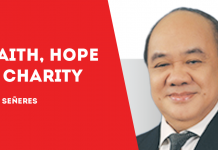
THE Human Development Index (HDI) is a summary composite index that measures a country’s average achievements in three basic aspects of human development: health, knowledge, and a decent standard of living.
Health is measured by life expectancy at birth; knowledge is measured by a combination of the adult literacy rate and the combined primary, secondary, and tertiary gross enrolment ratio; and standard of living by the Gross Domestic Product (GDP) per capita (Source: United Nations).
As used by the United Nations, the statistic of life expectancy at birth is just another way of measuring the mortality rate of a country. In a similar manner, the statistic of knowledge is just another way of measuring the illiteracy rate of the country, and the statistic of the standard of living is just another way of measuring the poverty rate of a country.
I see the need to standardize the adoption of the HDI method for our country as a whole. As a member of the United Nations, our government is already using HDI as a national measure. However, it is still not the practice of the Local Government Units (LGUs) to adopt HDI as the common method of measuring human development at the local level. Strictly speaking, the national HDI data should be derived from the actual data that is collected from the LGU level.
The HDI method does not directly use the poverty rate to measure the standard of living of a country. It uses instead the statistic of the GDP per capita, using the purchasing power parity (PPP) method of computation.
PPP is a theory of long-term equilibrium exchange rates based on relative price levels of two countries (Source: Wikipedia). Setting aside the technical jargon however, the fact remains that our country has a very high poverty rate, meaning that the standard of living of the majority of our people is very low.
In 2010, the Philippines ranked number 105 in the 2009 HDI Report of the United Nations Development Program, under the classification of “Medium Human Development”. On the positive side however, the Philippines ranked number 36 in the 2009 GDP-PPP list of the International Monetary Fund (IMF).
I believe that our right approach should be to improve our adult literacy rate by increasing access to educational and professional services, to improve our standard of living by increasing access to legal and commercial services and to improve our life expectancy by increasing access to medical and dental services. I have named this the Educational, Legal and Medical approach, or the ELM approach for short.
As it is now, our country has a very high adult literacy rate already. On the negative side however, we have a very low gross enrolment ratio, which in the final computation effectively lowers our national measure of knowledge. I believe that the solution to this is to increase our gross enrolment ratio through alternative learning approaches.
Moreover, I believe that the our official standard for our national measure of knowledge should be raised from the basic “read and write” measure, to a more specific measure of graduating from a vocational or a professional course, so that our individual citizens could become more competitive in the global marketplace.
In prior articles, I wrote that livelihood is the solution to poverty. I still believe in that, but under the ELM approach, I am now giving a new focus to the provision of legal services as a way to break down the barriers that are now making it difficult for our individual citizens to improve their standard of living.
This could include barriers to productive employment or to owning a business, hence the emphasis on commercial services. It is good to note that many organizations are sponsoring free medical and dental clinics, and this should be encouraged, but we do need more free legal clinics too.
In a manner of speaking, the race to get higher HDI and GDP scores is like a battle among nations that should be given more importance than the World Cup and the Olympics. All of our national energies should be focused on these two priority goals, and the best place to start is putting good order into our implementation at the local level./PN





